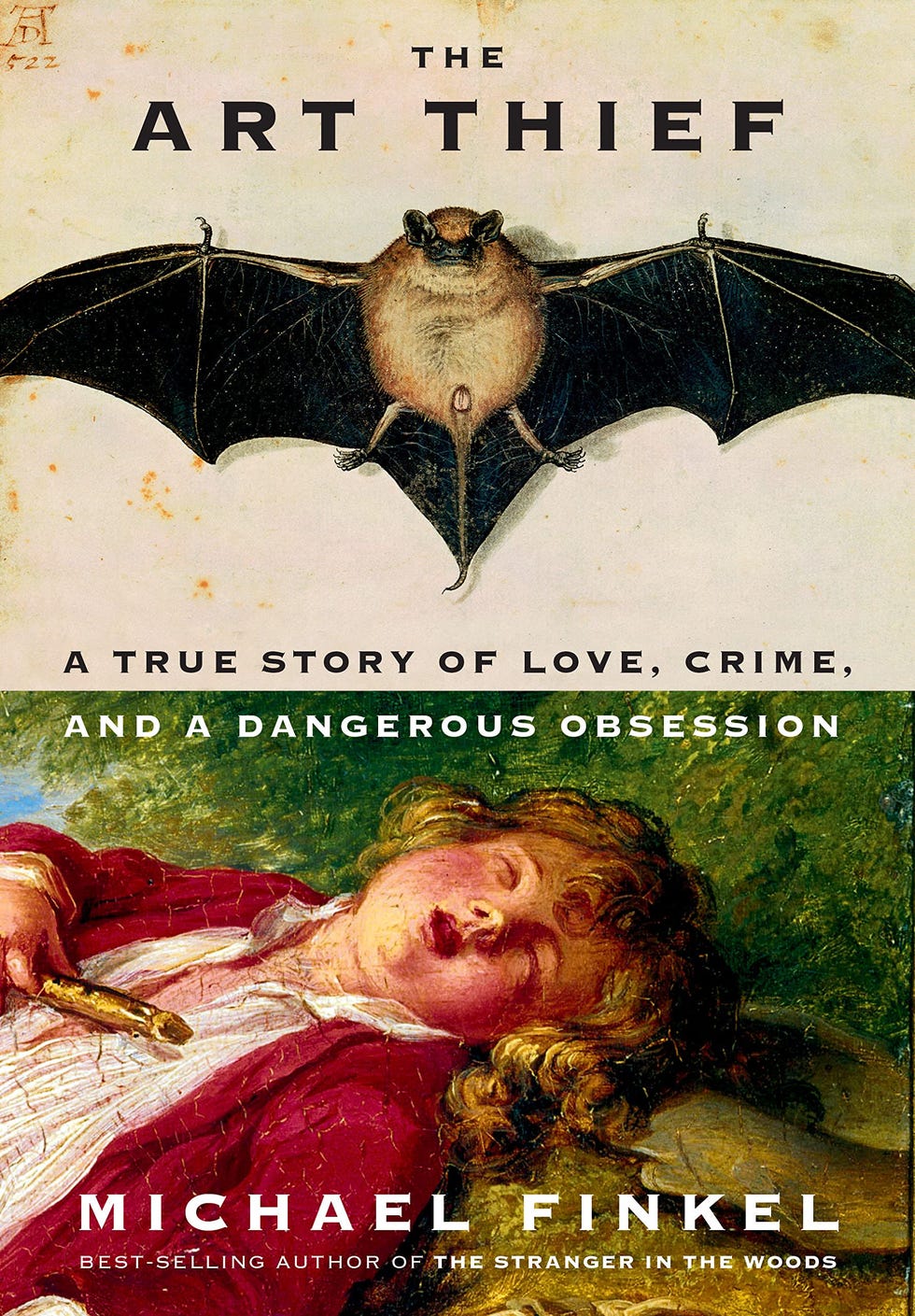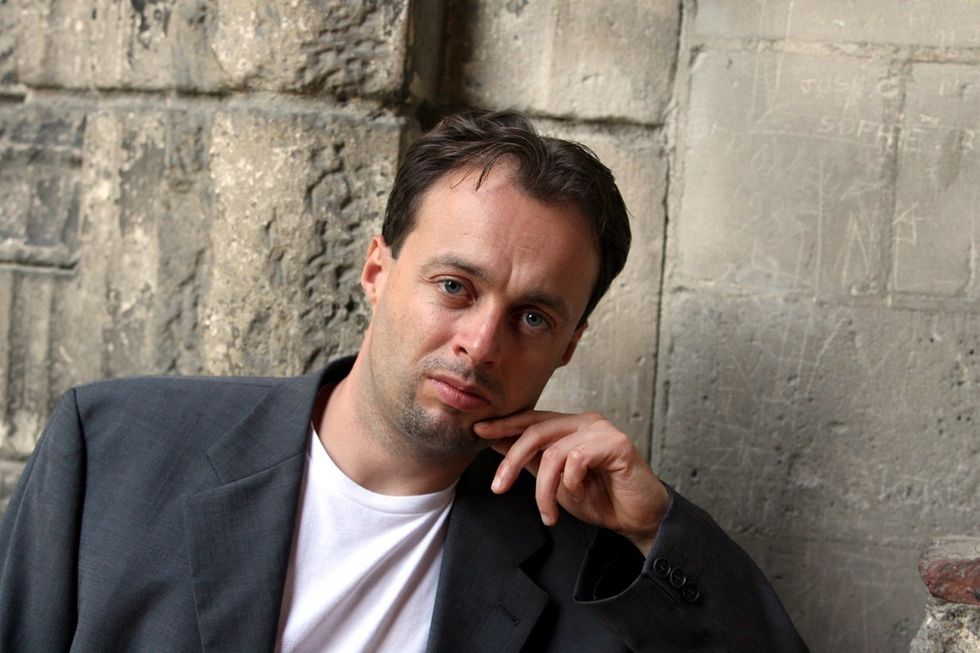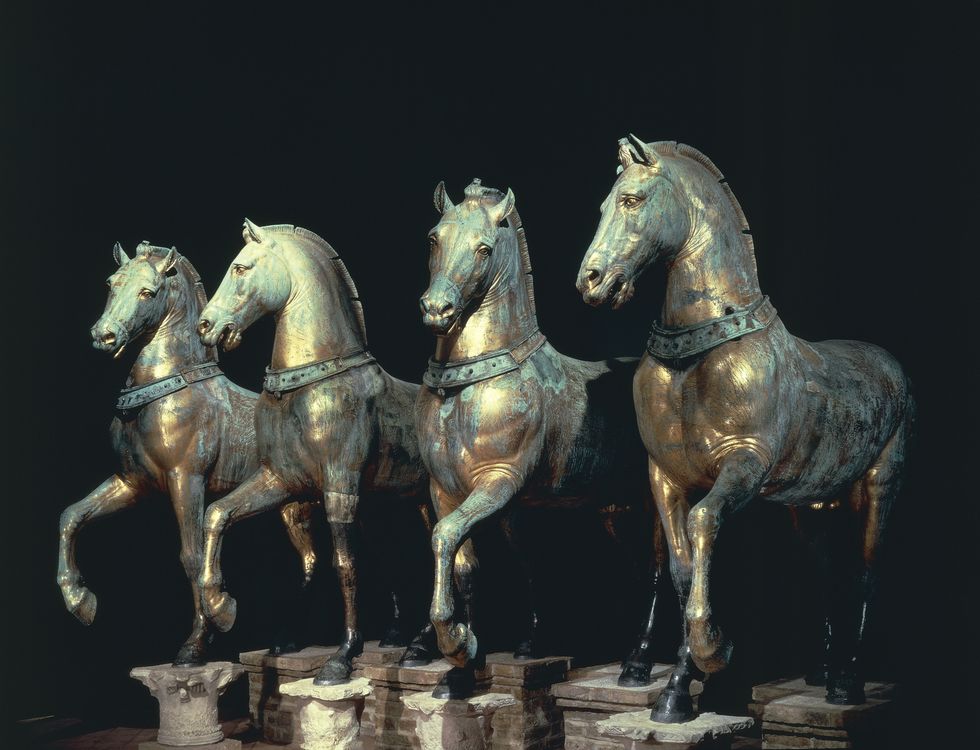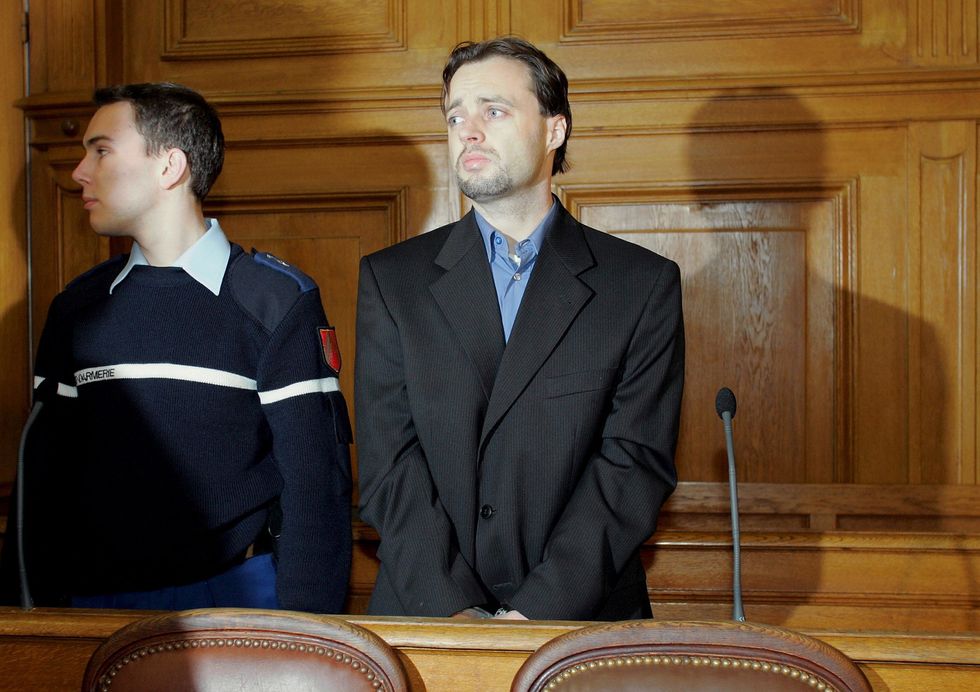Art
Michael Finkel Unravels The True Story Behind the Frenchman Who Stole $2 Billion Worth of Art
“A thing of beauty is a joy forever,” John Keats once wrote. “Its loveliness increases; it will never pass into nothingness.” The poet’s immortal words should be emblazoned on the family crest of Stéphane Breitwieser: aesthete, depraved genius, and according to author Michael Finkel, “perhaps the most successful and prolific art thief who has ever lived.”
From 1994 to 2001, Breitwieser romped through Europe on a breathtaking crime spree: roughly three weekends out of every four, he nicked priceless works of art from museums, galleries, and auction houses, amassing a collection that ultimately totaled more than 300 works of stolen art valued at upwards of $2 billion. But Breitwieser’s heists looked nothing like Ocean’s Eleven or To Catch a Thief. Unmasked, undisguised, and armed only with a Swiss Army Knife, Breitwieser waltzed into these sanctuaries with no target, no master plan, no meticulous map of the nearest exits—rather, he stole impulsively, making off with whatever entranced him.
His secret weapon was his girlfriend Anne-Catherine Kleinklaus, who acted as his lookout and sometimes smuggled artworks in her handbag. Unlike the gentleman burglars of Ocean’s Eleven, Breitwieser had no intention of fencing his ill-gotten goods for profit: instead, he stored his dragon’s hoard in his attic bedroom at his mother’s home in eastern France, where he and Kleinklaus admired their treasure trove while lying in bed. A sometimes-waiter living off the paltry salary Kleinklaus earned as a nurse’s aide, Breitwieser was notoriously cheap for a man harboring dozens of Old Masters; once, while fleeing a museum heist with two 16th-century altarpiece panels tucked under his jacket, he argued with a police officer slapping a parking ticket on his getaway car. He drove off with the stolen panels in plain sight—and successfully convinced the officer to nix the ticket, too.
Finkel recounts all this and more in his exhilarating new book, The Art Thief: A True Story of Love, Crime, and a Dangerous Obsession. Constructed from hours of intensive interviews, The Art Thief traces Breitwieser’s upper class childhood, his family’s fall from grace, and the obsession with high art that’s underpinned his entire life. Finkel places us squarely in Breitwieser’s shoes: standing in front of a Brueghel, or a Cranach, or a Rubens, thinking about how it ought to be liberated from this “prison for art” (as Breitwieser describes museums), we feel a frisson of dangerous possibility. Finkel’s narrative thrills and electrifies, until it all barrels toward inevitable capture, two shocking betrayals, and an astonishing conclusion. We won’t divulge the twists and turns for readers unfamiliar with Breitwieser’s story, but know this much: parts of Breitwieser’s collection went up in (literal) flames, while others ended up shredded with scissors, stuffed down the garbage disposal, or afloat in the Rhone-Rhine Canal. To this day, over 80 priceless treasures remain unaccounted for.
Finkel spoke with Esquire by Zoom to take us inside the eleven-year process of reporting this story–and inside the “bumpy but fun, fascinating, and all-consuming relationship” he formed with Breitwieser. This interview has been edited for length and clarity.
ESQUIRE: Where did this book begin for you, and how did it take shape over time?
MICHAEL FINKEL: I had read a few things in the French media about this ridiculously prolific art thief, Stéphane Breitwieser. I called a few French journalists, who said the magic competitive journalist words: “This guy isn’t speaking to any journalists, and certainly not to an American.” I ended up writing him a handwritten letter. From my first letter to Breitwieser to actually owning a book that I can tap on the table, it’s been more than eleven years. After many handwritten letters and a very tentative lunch meeting, he eventually agreed to 40 hours of interviews, and we also went on some road trips. It was fascinating to visit art museums with the world’s most prolific art thief. A bumpy but fun, fascinating, and all-consuming relationship ensued between the two of us.
What was it like to visit a museum with Breitwieser?
Working on this book changed the way I experience museums and commune with a work of art. Breitwieser is often low energy; then, when he walks into a museum, it’s like he’s had a triple shot of espresso. This is someone who’s very parsimonious with his words, then suddenly he’s babbling like your favorite crazy art professor. I would watch his face as he stood in front of an artwork. If he didn’t like something, it was a flat face. If he liked something, it was as if he’d been electrocuted, and he’d often look around the room to see if he could commune alone with it. In front of a Rubens, he once said to me, “Paintings are not two-dimensional—they’re three-dimensional. They’re like microscopic sculptures.” Then he took my hand and rubbed it lightly against the corner of the painting.
I’ll admit it—feeling the ridges of the paint that Peter Paul Rubens had applied there in the 17th century, I got goosebumps. I was doing something illegal, but I was also really in the moment. Then he would talk about the work—about the painting, the color, the frame, how it was attached to the wall, how best to remove it from the wall, how to remove the frame, where to hide the painting on your body, which exit to take, where you should drive your getaway car, and where the painting should hang in your home. He’s not your everyday tour guide. I try to capture some of that exuberance and craziness in the book.
You spent a lot of time with Breitwieser in an effort to understand him. You write, “He hopes to satisfy some hole inside him. Though no matter how much he steals, the emptiness never feels filled.” What do you think that hole is?
At the risk of being a pseudo-psychologist, this is something that does happen with collectors. Whether you think Breitwieser is a kleptomaniac or a common thief, he really does have an aesthetic sense, and he considers himself a collector. Research about the pathology of obsessed collectors suggests there’s this sense that you’re never finished. There’s never a moment where an obsessed collector thinks, “I’ve got the last painting. Now I have the complete set, so I’m going to stop.” I’m hesitant to compare it to drug addiction, but collecting shares that quality where the pursuit of something almost gives you more adrenaline than the possession of it. I think Breitwieser always thought, This next piece will be the one that finally makes me feel like I’m like a whole person. Then two days later, he would find his head turning in another direction. In speaking with him, I felt that very fully—this sense that he was trying to fill a bucket with a huge hole in the bottom.
It’s heartbreaking and infuriating to read. There are so many times when he comes so close to getting on the straight and narrow, but inevitably, he just can’t help himself.
In nonfiction, you get very close to the subject, and sometimes it’s hard to lower the boom. The way that everything in his life falls apart—I found it to be heartbreakingly sad. But on the other hand, he deserved to be punished and he dug his own grave. What I like in a good story is when an author doesn’t tell you how to feel about someone. I like when they put it on the table for you to decide. I don’t like to hold back in my stories—I’m going to show the whole truth, warts and all. I love when people read my books and tell me, “I hated that guy,” “I loved that guy,” and everything in between. When there’s a multitude of reactions, I feel like maybe I put this person down on paper correctly. Even after eleven years, I’m not sure exactly how I myself feel about him. There’s sometimes respect, sometimes disgust, and sometimes everything else in between.
You write, “Very few individuals or gangs have pulled off a dozen or more heists.” Breitwieser pulled off hundreds. What were the keys to his success, in your view?
There’s no doubt in my mind that this man is a born master thief. He has amazing amounts of chutzpah, but he also has a spontaneity gene like nobody I’ve ever seen. But even more complexly, he fell in love with Anne-Catherine Kleinklaus. They truly loved each other, even though it was the most unhealthy relationship I’ve encountered. The relationship empowered him—a good lookout helps immensely. I compare her to a magician’s assistant, because half the time it’s the assistant that’s really doing the trick while the magician is up there waving his cape.
Most thieves spend so much time planning a caper, but Breitwieser’s ability to decide how to steal something in the heat of the moment is both insane and brilliant. When I first started writing this book, I thought, “People are going to want skylight entries and shootouts and smoke bombs,” but that’s not what this is about. This is a true story, and I love the little things—like when a thief gets caught stealing at a major art show, security is tackling the thief, and Breitwieser thinks, “This is the perfect time to steal.” Give me ten years to plan a heist and I wouldn’t have come up with that, but he did it spontaneously. I don’t approve of any of it, but I have to nod my head at the sheer risks he took. I can’t believe how long he got away with it.
Anyone reading this book would walk away and think, Museums should tighten their security. But as you point out, it’s not that simple—there’s a complicated equilibrium between making art accessible enough to enjoy, but secure enough to be safe. Where should museums go from here?
This touches on a complicated question that I never really thought about before writing the book: “What’s the role of a museum?” Public museums are one of the great things about modern society. We can see artworks that only billionaires could own, and we can actually commune with them. The goal of a museum, of course, is to make the art feel as close as possible. Even putting a piece of glass on a painting is considered bad form—it’s rarely done. There’s a pact between the public and the museum that’s unstated: the public won’t get too close to these priceless objects, but they’re literally within our reach. If you wanted to punch a hole in a Van Gogh, you could do it, yet nobody does. Breitwieser is a cancer on that public good. I hope that in the future, there won’t be big pieces of glass in front of all the paintings that I love to see. But without changing the true nature of museums, there’s not much more we can do to keep these artworks safe. The fact of the matter is that by the very nature of a museum’s mission, they’re going to be vulnerable.
Breitwieser says of museums, “The story of art is a story of stealing.” I have to admit—I think there’s some truth to that statement, particularly when we look at the long history of empires looting treasures from other cultures. The British Museum has an entire webpage devoted to what they call “contested objects”—or “stolen property” by another name. Do you think there’s any truth to Breitwieser’s view?
I do. There’s something profoundly damaging about stealing another culture’s heritage. When the European explorers first reached the Inca Empire and tried not just to conquer their people, but to take their treasures, it was like saying, “I want to take the things that are attached to your soul.” If your house was burning, you’d take your photo album and your kids’ drawings—those are worth nothing, but they’re worth everything. You can replace your car before you can replace a work of art. Art is unique and individual, and it’s been stolen forever.
What if we tried to return everything to where it belonged? In the book I mention the crazy case of the Horses of Saint Mark, which were made in ancient Greece. Then they went to Rome, then to Constantinople, then to Turkey, then to Venice, then to Paris. When the British captured them after the fall of Napoleon, they decided to return them to where they belonged—which they decided was Venice. How do you unwind all that history? Breitwieser’s contention that the art world is hive of immorality isn’t 100% wrong. But that doesn’t mean that we should just throw up our hands. That’s the Lance Armstrong excuse—“a bunch of other people are doping, so I’m just going to dope away.” There goes the downfall of society. Breitwieser isn’t wrong, but as with many bits of logic, it can be twisted to fit an agenda.
What’s your view of the women in Breitwieser’s life? What’s their degree of complicity in this story?
As it says right in the opening pages of the book, I did not have the chance to personally interview Anne-Catherine Kleinklaus, nor Breitwieser’s mother, Mireille Stengel. I completely understand why Anne-Catherine did not want to speak to me; she really painted herself into a strange corner in her trial. On some level of the crazy triangle between mother, son, and girlfriend, I almost find the mother and the girlfriend to be the most compelling characters. But in the realm of nonfiction, I can only work with what I have. I wish I knew more, but there’s no way to know more. Sometimes in life, a little of a story is better than none. But how much more story is there? I’m riveted by them both and think they’re arguably more dimensional than Breitwieser.
Will we ever know what happened to those 80 pieces of art that remain missing? Stengel may be the only person who knows, and that’s torture.
I’ve gotten a little obsessed with that question. In fact, I’ve been heading to France on a treasure hunt to see if I can find any of those pieces. I was hoping to say that I had found one by now. My plan is to find some of these missing pieces and of course return them to museums. Maybe between the finding and the returning, if it’s a great silver chalice, I’ll have a good glass of wine.
This is how it starts. That’s how you become the next Breitwieser.
I’m returning it, I promise. You can see how the fate of these missing pieces has bedeviled me. Where did they go, and why can’t they be returned?
I’m surprised there’s been no giant scavenger hunt in France. You’d think that the French would be combing the countryside in search of their treasures.
People don’t even know where to start digging on private property, and police officers themselves have given up. Their take is, “We caught our guy and we’ll let these mysteries lie.” But there are some beautiful pieces that I would like to see again. Where the heck are they? What a weird ending.
Where is Breitwieser now? What’s his daily life like?
I went to his latest trial in March 2023. He put on quite the performance, crying and begging for mercy—it was a little bit heartbreaking. I thought he was going to go to jail for five or six years, but he managed to get house arrest. He has to wear an ankle monitor and he’s going to be in the penal system until he’s almost 60 years old. He’s living at his grandparents’ farmhouse that his mother now caretakes, and as always, he probably thinks about stealing more. He’s probably not working. He’s like an annoying man child, at times. I’m sure his mother is continuing to support him. Of course, he has a girlfriend. Will he be able to resist the siren song of art hanging on people’s walls? I wonder.
Why do we love heist stories like Breitwieser’s? Somehow we can’t get enough of these crimes.
A heist is a very specific form—it has to be the right kind of crime, right? The reason why Breitwieser’s story so attracted me was the fact that there was no violence used during the heists, and there was no attempt to monetize it until the very end. It was all done out of love. I think everybody wonders what it’s like on the dark side. I know that I do. What would it actually be like to steal a work of art, or to get away with something so utterly cancerous to society? We all have that curiosity—why else would the news be packed with depressing or uncomfortable stories? I don’t think we should resist our curiosity. We should resist our actions, but let our curiosity run wild. We all wonder about the heroes and the freedom fighters, but also the ruffians, the scallywags, and the rule-breakers.
Books and Fiction Editor
Adrienne Westenfeld is the Books and Fiction Editor at Esquire, where she oversees books coverage, edits fiction, and curates the Esquire Book Club.

Art
Calvin Lucyshyn: Vancouver Island Art Dealer Faces Fraud Charges After Police Seize Millions in Artwork

In a case that has sent shockwaves through the Vancouver Island art community, a local art dealer has been charged with one count of fraud over $5,000. Calvin Lucyshyn, the former operator of the now-closed Winchester Galleries in Oak Bay, faces the charge after police seized hundreds of artworks, valued in the tens of millions of dollars, from various storage sites in the Greater Victoria area.
Alleged Fraud Scheme
Police allege that Lucyshyn had been taking valuable art from members of the public under the guise of appraising or consigning the pieces for sale, only to cut off all communication with the owners. This investigation began in April 2022, when police received a complaint from an individual who had provided four paintings to Lucyshyn, including three works by renowned British Columbia artist Emily Carr, and had not received any updates on their sale.
Further investigation by the Saanich Police Department revealed that this was not an isolated incident. Detectives found other alleged victims who had similar experiences with Winchester Galleries, leading police to execute search warrants at three separate storage locations across Greater Victoria.
Massive Seizure of Artworks
In what has become one of the largest art fraud investigations in recent Canadian history, authorities seized approximately 1,100 pieces of art, including more than 600 pieces from a storage site in Saanich, over 300 in Langford, and more than 100 in Oak Bay. Some of the more valuable pieces, according to police, were estimated to be worth $85,000 each.
Lucyshyn was arrested on April 21, 2022, but was later released from custody. In May 2024, a fraud charge was formally laid against him.
Artwork Returned, but Some Remain Unclaimed
In a statement released on Monday, the Saanich Police Department confirmed that 1,050 of the seized artworks have been returned to their rightful owners. However, several pieces remain unclaimed, and police continue their efforts to track down the owners of these works.
Court Proceedings Ongoing
The criminal charge against Lucyshyn has not yet been tested in court, and he has publicly stated his intention to defend himself against any pending allegations. His next court appearance is scheduled for September 10, 2024.
Impact on the Local Art Community
The news of Lucyshyn’s alleged fraud has deeply affected Vancouver Island’s art community, particularly collectors, galleries, and artists who may have been impacted by the gallery’s operations. With high-value pieces from artists like Emily Carr involved, the case underscores the vulnerabilities that can exist in art transactions.
For many art collectors, the investigation has raised concerns about the potential for fraud in the art world, particularly when it comes to dealing with private galleries and dealers. The seizure of such a vast collection of artworks has also led to questions about the management and oversight of valuable art pieces, as well as the importance of transparency and trust in the industry.
As the case continues to unfold in court, it will likely serve as a cautionary tale for collectors and galleries alike, highlighting the need for due diligence in the sale and appraisal of high-value artworks.
While much of the seized artwork has been returned, the full scale of the alleged fraud is still being unraveled. Lucyshyn’s upcoming court appearances will be closely watched, not only by the legal community but also by the wider art world, as it navigates the fallout from one of Canada’s most significant art fraud cases in recent memory.
Art collectors and individuals who believe they may have been affected by this case are encouraged to contact the Saanich Police Department to inquire about any unclaimed pieces. Additionally, the case serves as a reminder for anyone involved in high-value art transactions to work with reputable dealers and to keep thorough documentation of all transactions.
As with any investment, whether in art or other ventures, it is crucial to be cautious and informed. Art fraud can devastate personal collections and finances, but by taking steps to verify authenticity, provenance, and the reputation of dealers, collectors can help safeguard their valuable pieces.
Art
Ukrainian sells art in Essex while stuck in a warzone – BBC.com
[unable to retrieve full-text content]
Ukrainian sells art in Essex while stuck in a warzone BBC.com

Source link
Art
Somerset House Fire: Courtauld Gallery Reopens, Rest of Landmark Closed
The Courtauld Gallery at Somerset House has reopened its doors to the public after a fire swept through the historic building in central London. While the gallery has resumed operations, the rest of the iconic site remains closed “until further notice.”
On Saturday, approximately 125 firefighters were called to the scene to battle the blaze, which sent smoke billowing across the city. Fortunately, the fire occurred in a part of the building not housing valuable artworks, and no injuries were reported. Authorities are still investigating the cause of the fire.
Despite the disruption, art lovers queued outside the gallery before it reopened at 10:00 BST on Sunday. One visitor expressed his relief, saying, “I was sad to see the fire, but I’m relieved the art is safe.”
The Clark family, visiting London from Washington state, USA, had a unique perspective on the incident. While sightseeing on the London Eye, they watched as firefighters tackled the flames. Paul Clark, accompanied by his wife Jiorgia and their four children, shared their concern for the safety of the artwork inside Somerset House. “It was sad to see,” Mr. Clark told the BBC. As a fan of Vincent Van Gogh, he was particularly relieved to learn that the painter’s famous Self-Portrait with Bandaged Ear had not been affected by the fire.
Blaze in the West Wing
The fire broke out around midday on Saturday in the west wing of Somerset House, a section of the building primarily used for offices and storage. Jonathan Reekie, director of Somerset House Trust, assured the public that “no valuable artefacts or artworks” were located in that part of the building. By Sunday, fire engines were still stationed outside as investigations into the fire’s origin continued.
About Somerset House
Located on the Strand in central London, Somerset House is a prominent arts venue with a rich history dating back to the Georgian era. Built on the site of a former Tudor palace, the complex is known for its iconic courtyard and is home to the Courtauld Gallery. The gallery houses a prestigious collection from the Samuel Courtauld Trust, showcasing masterpieces from the Middle Ages to the 20th century. Among the notable works are pieces by impressionist legends such as Edouard Manet, Claude Monet, Paul Cézanne, and Vincent Van Gogh.
Somerset House regularly hosts cultural exhibitions and public events, including its popular winter ice skating sessions in the courtyard. However, for now, the venue remains partially closed as authorities ensure the safety of the site following the fire.
Art lovers and the Somerset House community can take solace in knowing that the invaluable collection remains unharmed, and the Courtauld Gallery continues to welcome visitors, offering a reprieve amid the disruption.
-

 Sports24 hours ago
Sports24 hours agoArmstrong scores, surging Vancouver Whitecaps beat slumping San Jose Earthquakes 2-0
-

 News24 hours ago
News24 hours agoAs plant-based milk becomes more popular, brands look for new ways to compete
-

 News20 hours ago
News20 hours agoLabour Minister praises Air Canada, pilots union for avoiding disruptive strike
-

 News5 hours ago
News5 hours agoNova Scotia premier repeats calls for Ottawa to pay for protecting Chignecto Isthmus
-

 News5 hours ago
News5 hours agoEmir of Qatar to visit Ottawa on what will be his first official trip to Canada
-

 News5 hours ago
News5 hours agoTIFF audience prizes for ‘Life of Chuck,’ Hip doc; Rankin among Canadian winners
-

 News20 hours ago
News20 hours agoLooking for the next mystery bestseller? This crime bookstore can solve the case
-

 News24 hours ago
News24 hours agoInflation expected to ease to 2.1%, lowest level since March 2021: economists


























